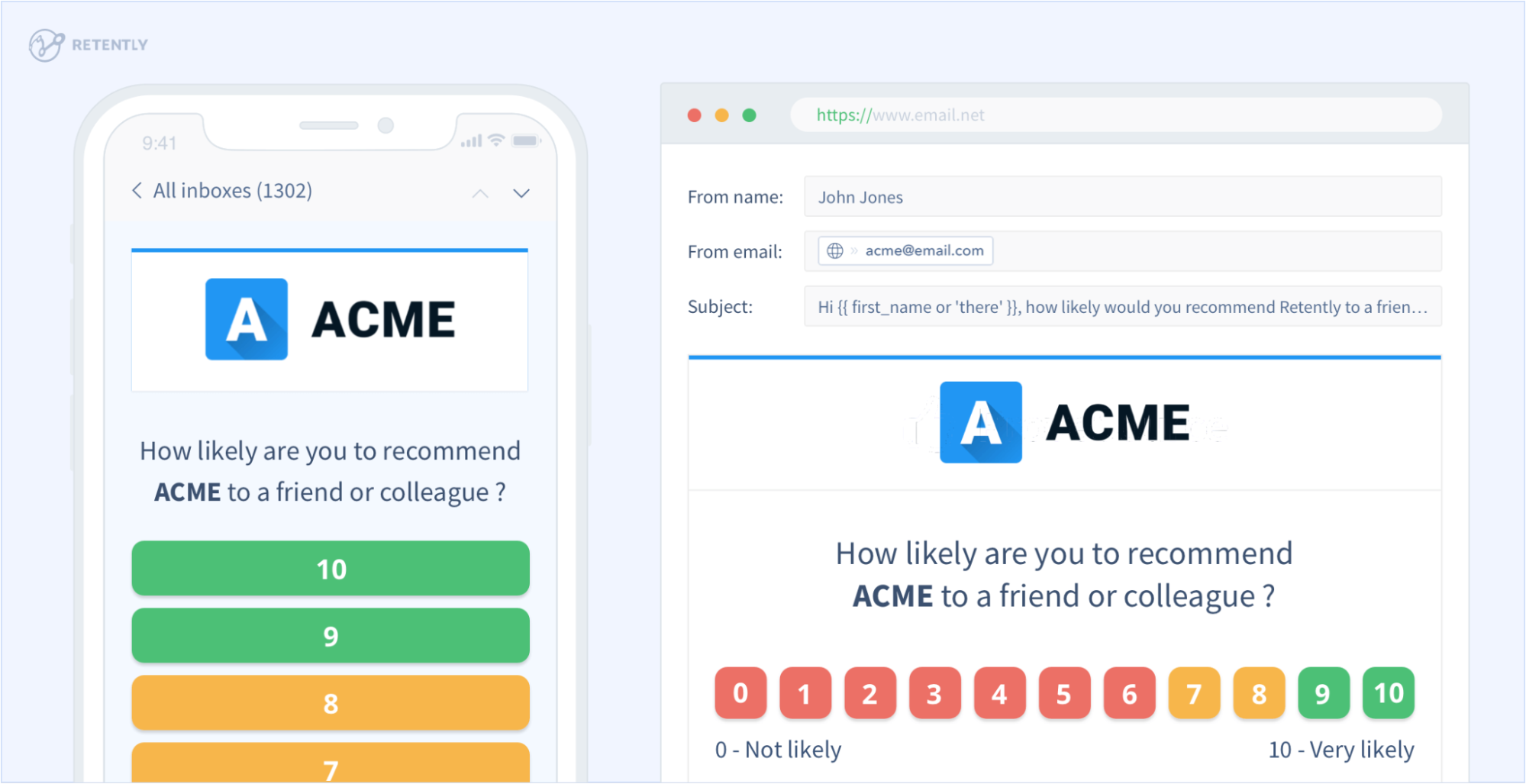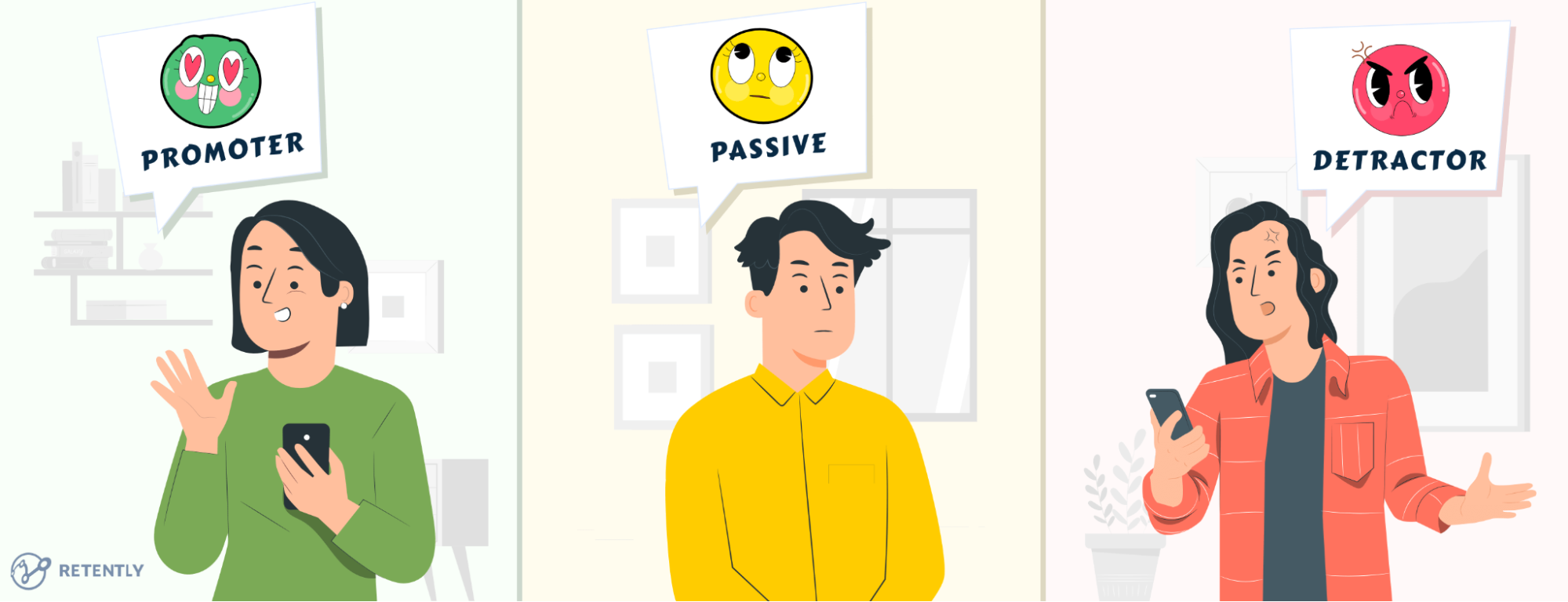Have you ever walked into a room full of people and wondered how to start a conversation with each individual? Likewise, businesses meet plenty of customers with unique needs and preferences. Understanding them becomes key to creating memorable experiences and fostering loyalty.
But here’s a twist: what if we told you there’s a handy tool to help categorize customers, making it easier to cater to their needs? It’s the Net Promoter Score (NPS). NPS offers a lens to segment your audience into three groups: the loyal Promoters, the on-the-fence Passives, and the critical Detractors.
But why all the buzz around NPS? Because knowing your product is half the battle. The real game-changer is knowing your customer. Recognizing where they stand on the satisfaction scale, predicting their next move, and crafting tailored customer experiences are what make some businesses thrive while others fail.
So, buckle up as we start our journey toward understanding the anatomy of the customer through NPS. From behavior to their impact on your business, let’s find out what customers think and feel.
NPS Explained: The What, Why, and How
What exactly is NPS? In the simplest of terms, it’s a measure of customer satisfaction and loyalty. NPS turns the idea of recommendation into a number based on a simple question: On a scale of 0 to 10, how likely are you to recommend our product/service to a friend or colleague?

The answers to the NPS survey question segment customers into three categories:
- Promoters (9-10): They are your brand champions. Promoters love what you offer and can’t stop telling others about it.
- Passives (7-8): They are satisfied but not head-over-heels. They won’t complain, yet competitors may easily pique their interest.
- Detractors (0-6): They are unhappy and can harm your brand through negative word-of-mouth.
Your NPS score is then calculated by subtracting the percentage of Detractors from the percentage of Promoters.
However, it’s not just about having a number; it’s about the insights that number provides. When one tweet or product review can influence thousands, understanding customer sentiment is a must. Hence, NPS isn’t just another metric. For many companies, it’s how they hear from customers and plan for better growth.
Promoters: The Enthusiastic Advocates
Think of the customers who love your product, are eager for your new releases, and always talk positively about your brand. These are your Promoters. They are the ones to rate you a solid 9 or 10, showing their strong likelihood to recommend you to others. Given their high scores, Promoters are defined by their enthusiasm, loyalty, and genuine love for what you offer.
Promoters are more than just satisfied customers; they are your brand ambassadors. Their word-of-mouth advocacy is a goldmine for marketing and organic growth. Consider them your business’s biggest fans, bringing in new customers by recommending you. Their loyalty often translates to repeated business, increased customer lifetime value, and, as a result, revenue. Basically, Promoters show that you’re on the right track.
How to Nurture Promoters
While it’s fantastic to have Promoters, keeping them engaged and loyal is the real challenge. Here are some quick tips on how to do that:
- Listen to Them: Regularly engage with them, ask for feedback, and show that you value their opinions.
- Be Consistent: Make sure that the quality and value they fell in love with remains consistent or improves over time.
- Provide Special Offers: Reward their enthusiasm. A well-structured loyalty or rewards program will strengthen their commitment. Offer special discounts or early access to new products/exclusive events.
- Build a Community: Create spaces, be it online forums or offline events, where they can connect with like-minded enthusiasts.
Check our dedicated article on the topic to dive deeper into the world of Promoters and gain a comprehensive understanding of their roles.
Passives: The Silent Observers
Imagine customers who are content with your product but not entirely blown away. They appreciate your offer but might switch to a competitor for a slightly better deal. When it comes to the NPS question, they sit comfortably in the middle, giving you a 7 or 8. These are the Passives – the silent majority that is easy to miss between the loud supporters and the vocal critics. They’re on the fence, satisfied but not enthusiastic, appreciative but not loyal.
At first sight, Passives might seem harmless. They don’t sing your praises, but don’t complain either. However, that is actually the challenge. Passive customers aren’t deeply connected to your brand, making them vulnerable to competitive offers. While they won’t drive away potential customers with negative feedback, they also won’t bring in new ones through word-of-mouth. They simply keep things steady but don’t help your business grow.
How to Engage Passives
It’s all about finding what’s missing and filling that gap. Here are some ideas to explore:
- Be Proactive: Don’t wait for Passives to come to you. Reach out to make them feel special and understand their specific needs. Sometimes, all a Passive needs to convert into a Promoter is to know that their voice matters.
- Close Feedback Loops: Actively seek their feedback. They might not be vocal about minor issues, but addressing them can improve customer experience. Create mechanisms where they can easily share their thoughts and follow up accordingly.
- Offer Feedback Incentives: Encourage Passives to voice their opinions. A discount on their next purchase or even simple recognition might do the trick.
- Keep Them Updated: Passives are often unaware of all your offerings. Regular updates and tutorials can ensure they get the most out of your product or service. You could also organize webinars, workshops, or even community events. These will help to get them involved and see the value.
Passives hold great potential. With a little push, they can turn from regular customers to supporters of your brand. Yet, if you want to learn more about Passive customers, be sure to check out this article. It’s packed with helpful information that will give you a better grasp of the topic.
Detractors: The Vocal Critics
We’ve all come across them, perhaps even been one at some point. So, who are the Detractors? Detractors are customers who, for one reason or another, haven’t had the best experience with your product or service. When posed the NPS question, they score you between 0 and 6. They are not just dissatisfied; they’re vocal about their dissatisfaction and won’t hesitate to share it with others.
To address Detractors, one must first understand them and the reasons for their dissatisfaction. This could be because of glitches/bugs or other issues that shadowed their user experience, a negative customer support interaction, or unmet expectations.
While dismissing Detractors as difficult customers is easy, their feedback can be invaluable. They highlight existing issues, allowing businesses to improve their product. Moreover, when word-of-mouth can spread like wildfire, a Detractor can significantly affect a brand’s reputation.
How to Win Over Detractors
Addressing Detractors isn’t just damage control; it’s an opportunity for growth. Try the following strategies for a starter:
- Ensure Open Channels: Give them a platform to share their worries. Sometimes, a patient ear is all they’re looking for. Try to understand their pain points and care to fix them.
- Offer Swift Response: Instead of dismissing negative feedback, adopt a problem-solving mindset. Address their issues promptly. The faster you act, the more likely you are to save the relationship.
- Apologize and Make Amends: If you’ve fallen short, acknowledge and improve. An honest apology paired with action goes a long way.
- Implement Feedback: Use Detractor feedback to improve your product and show them that their insight makes a difference.
- Regularly Check In: Prove your commitment to becoming better. Prioritize regular check-ins, especially with those who’ve expressed concerns in the past.
While dealing with Detractors might seem tough, there’s a bright side to it. Detractors can convert not only into Passive users but sometimes into your most loyal Promoters. It’s about addressing issues, connecting with them, and always aiming to provide the best experience.
For more insights, don’t miss the opportunity to explore our dedicated article on Detractors. It provides a wealth of info worth your attention.
Infographic: Crunching the Numbers
The old saying goes: “A picture is worth a thousand words.” Indeed, numbers often speak louder than words. To truly grasp the impact and importance of Promoters, Passives, and Detractors, let’s look into an infographic that provides a snapshot of these customer segments in hard numbers.

Promoters
- They are loyal customers: Promoters are the backbone of your business, ensuring stability. Often, they are the first to pay more for an enhanced offering.
- They are brand defenders: A Promoter isn’t just a fan; they’ll stand up for you against critics, champion your cause, and consistently vouch for your brand.
- They are willing to stake their reputation: While an online endorsement of your company is a bold statement, your top Promoters will often take it one step further.
- Promoter referrals usually account for 20 – 50% of a company’s revenue. In some industries, the number can soar to as high as 80%.
Passive customers
- Passives are likely to churn within 6 months: On average, 20 – 30% of Passives will churn within 180 days or so, depending on your business model. You must promptly address the needs of your Passives customers’ needs and learn what it takes to earn that recommendation.
- Passives are not loyal to your brand: They are the quickest to switch brands when something better comes along. To earn their loyalty, you need to engage in meaningful discussion and show them that you’re more than just the product or service they purchased.
- They are price-sensitive: They will steer your business into a low-margin leadership position. Satisfaction isn’t the same as happiness. While Passives may be content, that doesn’t mean they are happy. It’s your job to figure out why. Once you do, it’s time to tackle that satisfaction gap.
Detractors
- They are likely to churn within 3 months: Up to 40 – 50% of your Detractors will leave within the next 90 days (or sooner). If your goal is to reduce churn, it’s critical to respond as quickly as possible (meaning immediately) and address their concerns.
- They speak louder than Promoters: They are nearly twice as likely to share a negative experience with others than Promoters are to share a positive experience. One bad experience shared by a Detractor can overshadow a good experience shared by a Promoter.
- They are more likely to be your future Promoters: Your fiercest Detractors are quite similar to your top Promoters. They want what you offer and are eager for it to match their needs. Your job is to meet those needs.
While numbers are helpful, the real value is in the stories they share and the changes they motivate. This infographic isn’t just a picture of now but a guide for what’s next, showing businesses where they can do better.
Boosting Your NPS: A Proactive Approach
We’ve looked closely at the anatomy of a customer and seen the numbers. Now, it’s action time. Improving your NPS is an ongoing journey that isn’t just about addressing the negatives; it’s about building on the positives and creating a great user experience.
Net Promoter Score isn’t just a number; it’s a peek into what your customers really think. And we want them to feel great about your product/service.
Understanding customer happiness can indeed feel overwhelming. But with Net Promoter Score, you’re up to the task. With this knowledge and strategies at hand, you’re not just aiming for a better score – you’re building an audience that believes in your brand and stands by it.
Start your Retently free trial and discover ways to boost your NPS further.





























 Greg Raileanu
Greg Raileanu 



 Alex Bitca
Alex Bitca 

 Christina Sol
Christina Sol